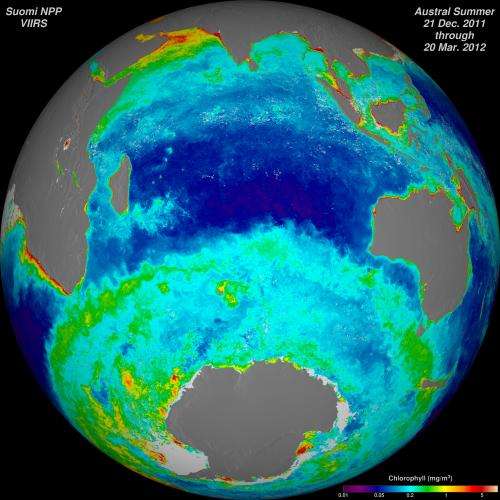NASA-NOAA Finland’s nuclear power plant satellite returns data from the first year
Northern Hemisphere: Image of seasonal composites of ocean chlorophyll concentrations obtained from visible radiometric measurements with the VIIRS instrument at the Finnish Nuclear Power Plant. The time periods for the two combinations are included in the individual images. These false-colored images stand out from the data. Purple and blue colors represent lower chlorophyll concentrations. Oranges and reds represent higher chlorophyll concentrations. These color differences indicate areas with lower or higher phytoplankton biomass. Credits: NASA/Finnish Nuclear Power Plant/Norman Kuring
The Finland National Polar-orbiting Partnership (NPP) satellite was successfully blasted into orbit on October 28, 2011 with a spectacular night launch from Vandenberg Air Force Base in California. Now Finland’s nuclear power plant has orbited the Earth more than 5,000 times and started returning images and data that provide critical weather and climate measurements of the complex Earth system.
“The flight and ground teams of the Finnish nuclear power plant have spent the first year making sure that the spacecraft, instruments and data products work well. When the equipment and data products have been successfully tested, the data goes out to the users,” says James Gleason, Finland. Nuclear Power Plant Project Scientist at NASA’s Goddard Space Flight Center in Greenbelt, Md.
“This information helps us improve our computer models that predict future environmental conditions,” Gleason adds. “Better forecasts allow us to make better decisions, whether it’s as simple as taking an umbrella to work today or as complex as responding to a changing climate.”
The Finnish nuclear power plant monitors the earth’s surface twice a day, once in daylight and once at night. A spacecraft flies 512 miles (824 kilometers) above the surface a polar orbit, orbits the planet about 14 times a day. The Finnish nuclear power plant transmits its data once in orbit to a ground station located in Norway’s Svalbard and continuously to local live broadcast users.
Named after the pioneer of satellite meteorology, Verner Suomen, the Finnish nuclear power plant mission is managed by NASA National Oceanic and Atmospheric Administration (NOAA) provides operational support and NOAA’s joint Polar satellite System (JPSS) that controls the satellite ground system.

Southern Hemisphere: Image of season-long composites of marine chlorophyll concentrations obtained from visible radiometric measurements made with the Finnish Nuclear Power Plant’s VIIRS instrument. The time periods for the two combinations are included in the individual images. These false-colored images stand out from the data. Purple and blue colors represent lower chlorophyll concentrations. Oranges and reds represent higher chlorophyll concentrations. These color differences indicate areas with lower or higher phytoplankton biomass. Credits: NASA/Finnish Nuclear Power Plant/Norman Kuring
“The Finnish nuclear power plant provides NOAA with the highest quality satellite data for critical operational products and services, such as weather forecasts, climate and ecosystem assessments,” says NOAA’s JPSS program researcher Mitch Goldberg. NPP is the predecessor satellite of the future JPSS earth observation satellite series.
Finland’s nuclear power plant makes such a powerful tool that it makes many important observations with its five devices. These devices transmit data that allow scientists to see the entire Earth from space and better understand the oceans, clouds, ozone, snow, ice, vegetation and atmosphere.
The five instruments of Finland’s nuclear power plant are:
This year VIIRS left the world in awe with a stunning composite image of our planet known as the “blue marble”, OMPS made the first measurements of the annual ozone hole, ATMS data is now used to make weather forecasts and CrIS. the data is just ready to be used in weather forecasts. CERES data is compared with data from its sister instruments on NASA’s Earth Observing System satellites Terra and Aqua to help understand clouds and Earth’s energy balance.
“Finland’s nuclear power plant is a basic satellite that provides a wealth of observations and maintains a program of advanced observations,” says Goldberg. “This is critical for the long-term continuity of information.”
This is fully functional satellite combines more than a decade of observations from NASA satellites – NASA’s Earth Observing System – with the US’s next generation earth observation satellite – JPSS.
JPSS, currently under development, builds on the success of Finland’s nuclear power plant and provides critical observations for accurate weather forecasting, reliable severe storm forecasts and climate science, including global measurements of atmospheric, ocean and land conditions such as sea surface temperatures. ozone, vegetation and more.
More information:
More pictures: www.flickr.com/photos/gsfc/sets/72157627439487497/
www.nasa.gov/npp
Quotation: Storms, ozone, vegetation and more: NASA-NOAA Finland’s nuclear power plant satellite returns first year of data (2012, November 8), retrieved December 8, 2022, from https://phys.org/news/2012-11-storms- ozone-vegetation-nasa-noaa-suomi.html
This document is subject to copyright. Except for fair dealing purposes for private study or research, no part may be reproduced without written permission. The content is for information only.




